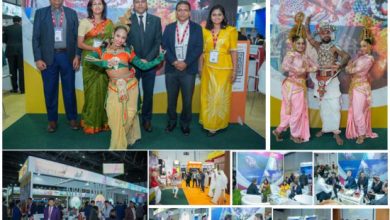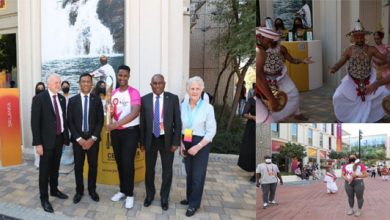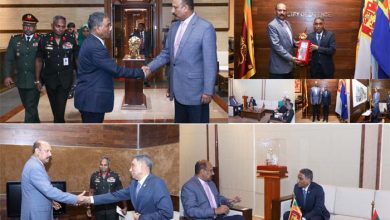The Sri Lankan Malay Heritage, Culture and Language
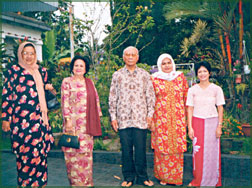
Sri Lanka, the Pearl of the Indian Ocean is blessed with an interesting cultural mosaic that has enriched the history, culture as well as the heritage of the island nation. In the 25,000 square miles of natural beauty which has been the home for diverse combination of several ethnic minorities Malays, now totaling about 80,000 people out of a total population of about 18 million are a colourful community who have contributed to the well being of Sri Lanka in different spheres.
Who are the Malays of Sri Lanka? How did they come to play an important role in the country’s affairs? These and other details of the Malay community is brought forth in the following article compiled by Sdr. Rilwan Lantra, President- Sri Lanka Malay Association(2014/15).
It is with great appreciation that we thank him for this valuable article that will enrich the readers of the Ceylondigest.
The Sri Lankan Malays belong to an integral segment of the Lankan community and have long since played a vital role in both the history and culture of the Island nation. As a community which is renowned for its valor and service to the motherland, the Malays have inevitably carved their own niche as an entity renowned for its glorious past, military honors, Art, language, literature, couture and cuisine. The Malays locally referred to as ‘Ja Minissu’, form an endangered community which traces its proud origins back from the Indonesian and Malayan archipelago. The country witnessed the antecedents of this extraneous minority mainly during the Dutch and British colonial eras. Many historical manuscripts trace their antecedents even prior to as early 6th century BC. The present day Malay community consists of those who claim Royal descent from the Spice Island of Indonesia. The rest are descendants of valiant mercenaries who were installed for service by the Dutch and British Colonists. The Malays in Sri Lanka form an intricate network of different ethnic groups such as Javanese, Bandanese, Sun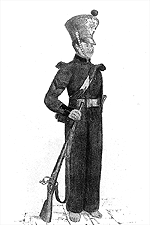 danese, ethnic Malays, Balinese, Makasarese, etc. so the term ‘Malays’ does not necessarily refer to the Ethnic Malays in Sri Lanka. Inste
danese, ethnic Malays, Balinese, Makasarese, etc. so the term ‘Malays’ does not necessarily refer to the Ethnic Malays in Sri Lanka. Inste
ad it was chosen as a conventional term by the British Officials to denote those who trace their ancestry from Malayan Peninsula and Indonesian archipelago.
During the bygone era, Malays were of much importance in the Lankan society, that Mahatma Gandhi during his three weeks long visit to Sri Lanka, in 1927, made it a point to mention Malays as part of the locals in almost every oration he delivered. This helps affirm the status enjoyed by them in an era gone by.
Sri Lankan Malay Culture
The word ‘sarong’ is a Malay word and is the national dress of the Malays. It is cheap and ideally suited for the climate. The ‘ja-hetta’ and the ‘kambaya’ worn by the Sinhalese women were introduced by the M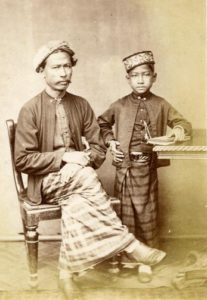 alays. ‘Kambaya’ is s a corrupt form of ‘kayen-bayen’ meaning in Malay a novel piece of cloth.’ The early Malay men wore their hair long, well-oiled and groomed with a knot (konde) fastened behind with a semi-circular comb made out of tortoise shell. The Sinhalese followed this style. In 1817, Sir Stamford Raffles wrote o the Javanese:”Neither the men nor the women cut their hair but allow it to grow to its natural length. The men except on particular occasions gathered it upon the crown of the head, twisted it round and fastened it by means o a semi-circular tortoise shell comb fixed in the front.” (History of Java 2nd edition 1830, London, p 99)There was also the style of wearing a cloth over the trousers which was called by the Sinhalese as ‘Redda Asse Mahathaya’, meaning ‘Gentleman inside three cloth.’ This type of dress was worn by the kings, royalty and nobles of Indonesia and Malaysia. In addition, a Batik scarf was used to cover the head, knotted on a side. Later on, the Batik scarf was contrived into a headgear – ‘Setangan Kepala.’ The Batik material has been now replaced by black velvet and the headgear is now called a ‘Songko.’ Malaya ladies have an ensemble of Batik cloth which comprises the Malay costume of which the Baju Koorung and Batik sarong with a scarf or Selendang to match is a fashion very much in vogue. In the field of cuisine, Malays are famous for preparing various types of delicacies and the traditional dessert is the Malay pudding ‘Siri-Kaya’ (rich-food), known as ‘Watalappan.’
alays. ‘Kambaya’ is s a corrupt form of ‘kayen-bayen’ meaning in Malay a novel piece of cloth.’ The early Malay men wore their hair long, well-oiled and groomed with a knot (konde) fastened behind with a semi-circular comb made out of tortoise shell. The Sinhalese followed this style. In 1817, Sir Stamford Raffles wrote o the Javanese:”Neither the men nor the women cut their hair but allow it to grow to its natural length. The men except on particular occasions gathered it upon the crown of the head, twisted it round and fastened it by means o a semi-circular tortoise shell comb fixed in the front.” (History of Java 2nd edition 1830, London, p 99)There was also the style of wearing a cloth over the trousers which was called by the Sinhalese as ‘Redda Asse Mahathaya’, meaning ‘Gentleman inside three cloth.’ This type of dress was worn by the kings, royalty and nobles of Indonesia and Malaysia. In addition, a Batik scarf was used to cover the head, knotted on a side. Later on, the Batik scarf was contrived into a headgear – ‘Setangan Kepala.’ The Batik material has been now replaced by black velvet and the headgear is now called a ‘Songko.’ Malaya ladies have an ensemble of Batik cloth which comprises the Malay costume of which the Baju Koorung and Batik sarong with a scarf or Selendang to match is a fashion very much in vogue. In the field of cuisine, Malays are famous for preparing various types of delicacies and the traditional dessert is the Malay pudding ‘Siri-Kaya’ (rich-food), known as ‘Watalappan.’ 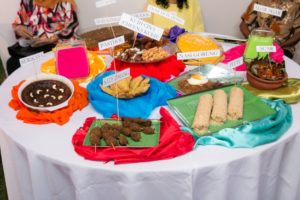 The popular rice-puller ‘achchar’ is also of Malay origin and popularly known as the Malay pickle. Dishes are also prepared out of different varieties of rice – Nasi K’mbooli (ghee Rice), Nasi Goreng (Fried Rice) and Nasi Kooning (Yellow Rice). Among the curries, there is the richly spiced ‘Sathay Daging’ also served roasted in bamboo skewers. Babath-Puruth’ and Daging Chuka’ – beef marinated in vinegar, spiced and cooked with sliced onions. Pasthol (Malay Patties), Bibikkan (cake), Dodol and Cheena Kuey are some of the desserts served with afternoon tea.
The popular rice-puller ‘achchar’ is also of Malay origin and popularly known as the Malay pickle. Dishes are also prepared out of different varieties of rice – Nasi K’mbooli (ghee Rice), Nasi Goreng (Fried Rice) and Nasi Kooning (Yellow Rice). Among the curries, there is the richly spiced ‘Sathay Daging’ also served roasted in bamboo skewers. Babath-Puruth’ and Daging Chuka’ – beef marinated in vinegar, spiced and cooked with sliced onions. Pasthol (Malay Patties), Bibikkan (cake), Dodol and Cheena Kuey are some of the desserts served with afternoon tea.
Handicrafts were introduced to the Island by the Malays. Schweitzer states that: “…The Malays made all sorts of lovely baskets from rattan.” – (Christian David, 1958, p. 7), and adds “….the original cane workers were Malays who plied their trade in Slave Island. They were expert builders. The ‘Creeses’ were turned out by Malay and Javanese craftsmen and their gold-smiths, also produced lovely filigree work on a solid background for decoration of pendants, bracelets, ear studs and rings. The embroidery turned out by their women folk was very popular among the Sinhalese women. The men were also expert painters woodcarvers and craftsmen who turned out their own musical instruments such as the Gamelan, violins, drums, etc., They were fond of song, music and dance. They composed their own poems (Stairs), pantuns and songs. Their women were adept at dancing – ‘Tari Payong” (Umbrella dance), ‘Tari C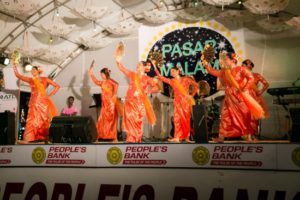 hinta Sayang’ (Dance of love), ‘Ronggeng’ (Dance to the lilt of Portuguese Kafringga) etc., to the accompaniment of the ‘gamelan’, ‘rabana’, violin and cymbals”. As much as they were fond of song, music and dance they were also staunch devotees of their faith – Islam.
hinta Sayang’ (Dance of love), ‘Ronggeng’ (Dance to the lilt of Portuguese Kafringga) etc., to the accompaniment of the ‘gamelan’, ‘rabana’, violin and cymbals”. As much as they were fond of song, music and dance they were also staunch devotees of their faith – Islam.
The Indigenous Language of Sri Lankan Malays
This article is meant to give an idea of the influence of Malay on the Sinhala Language and vice versa
The Sri Lankan Malay language is an off shoot of Malay which belongs to the Austronesian family of languages. When the Malays were first exiled to Ceylon they spoke the dialects of their individual islands from which they were brought. Since these dialects were unintelligible to one another they spoke Malay which was the lingua franca of the east at that time. The Malay they spoke was no different from what was spoken in Nusantara so much so that the first Malay Newspaper in the East, the “Alamat Lankapuri” found a circulation in Java and Singapore. As time went on, since the Malays were completely cut off from their motherland for over 200 years, their language changed in structure and vocabulary due to the influence of Sinhala and Tamil. Malay was originally written in the Arabic script with 5 additional letters (Gundul) but was later written in English Characters
Malay and Sinhala have a number of common or similar words in their respective languages. The words durian and rambuttan are derived from the Malay duri- thorn and rambut – hair respectively.
Many may recall the ditty “Aspaya goyang, goyang, goyang. Kolamba duwang, duwang, duwang” when they were rocked gently in their mothers laps. Now goyang in Malay is to shake, to swing, to rock (a cradle).[1]
The suffix lah attached to a verb in Malay signifies a request or cajoling. Marilah means Please come. Duduklah means Please sit. What can one think of the Sinhala verse “Kapanglah, Beepanglah, Jollikarapanglah. Heta marunoth hita tha sapay ada jollikarallah” which translated loosely means Eat drink and be merry for tomorrow we die. From where did the Malay lah come?
Here are a number of similar words in Sinhala and Malay.-This list is not exhaustive.
Sinhala Malay English Sinhala `Malay English
almariah lemari wardrobe bankuwa banku bench
karadasi kertas paper botale botol bottle
tinta tinta ink janela jendela window
lampuwa lampu lamp karattaya kereta cart(vehicle)
kamara kamar room sakuwa saku pocket
saroma sarong sarong sahodara saudara brother
saban sabun soap rahasa rahasia secret
The Malay language has its roots in Sanskrit and since Sinhala has also been influenced by Sanskrit it is natural that both Malay and Sinhala should have similar words.


